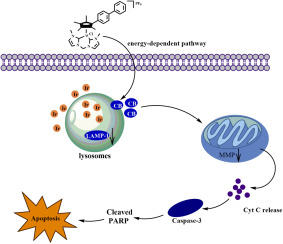当前位置:
X-MOL 学术
›
J. Inorg. Biochem.
›
论文详情
Our official English website, www.x-mol.net, welcomes your
feedback! (Note: you will need to create a separate account there.)
Lysosome-targeted chemotherapeutics: Anticancer mechanism of N-heterocyclic carbene iridium(III) complex.
Journal of Inorganic Biochemistry ( IF 3.8 ) Pub Date : 2020-03-19 , DOI: 10.1016/j.jinorgbio.2020.111063 Junming Zhang 1 , Jinfeng Liu 1 , Xicheng Liu 2 , Baoqing Liu 1 , Shaohua Song 1 , Xiangdong He 2 , Chengchuan Che 1 , Meiru Si 1 , Ge Yang 1 , Zhe Liu 2
Journal of Inorganic Biochemistry ( IF 3.8 ) Pub Date : 2020-03-19 , DOI: 10.1016/j.jinorgbio.2020.111063 Junming Zhang 1 , Jinfeng Liu 1 , Xicheng Liu 2 , Baoqing Liu 1 , Shaohua Song 1 , Xiangdong He 2 , Chengchuan Che 1 , Meiru Si 1 , Ge Yang 1 , Zhe Liu 2
Affiliation

|
N-heterocyclic carbenes-modified half-sandwich iridium(III) complex [(η5-C5Me4C6H4C6H5)Ir(C^C)Cl]PF6 (C1) (where C^C is a N-heterocyclic carbene ligand) can effectively prevent the proliferation of human cervical cancer cells. Here, this study aims to investigate the in-deep anticancer effects of this complex on non-small cell lung cancer cells and explore the underlying molecular mechanism. MTT (3-(4,5-dimethylthiazol-2-yl)-2,5-diphenyltetrazolium bromide) assay showed that iridium(III) complex had potent cytotoxicity studies towards non-small cell lung cancer cells (A549), human lung squamous cells (L78), human cervical cancer cells (Hela) and human bronchial epithelial cells (BEAS-2B). Colocalization and cellular uptake studies were analyzed by confocal microscopy. Notably, C1 targeted lysosomes and entered the cancer cells partially through an energy-dependent pathway, inducing the release of cathepsins and other proteins. These proteins regulated lysosomal-mitochondrial dysfunction, thus leading to the release of cytochrome c (cyt c), which amplified apoptotic signals by activating many downstream pathways such as caspase pathways to promote cell apoptosis. The results showed that the inhibitory mechanism of this organometallic iridium(III) complex may involve caspase-associated apoptosis initiated by the lysosomal-mitochondrial pathway.
中文翻译:

溶酶体靶向化疗:N-杂环卡宾铱(III)配合物的抗癌机制。
N-杂环卡宾修饰的半三明治铱(III)络合物[(η5-C5Me4C6H4C6H5)Ir(C ^ C)Cl] PF6(C1)(其中C ^ C为N-杂环卡宾配体)可以有效地防止扩散人宫颈癌细胞 在这里,本研究旨在研究该复合物对非小细胞肺癌细胞的深层抗癌作用,并探讨其潜在的分子机制。MTT(3-(4,5-二甲基噻唑-2-基)-2,5-二苯基四唑鎓溴化物)分析表明铱(III)配合物对非小细胞肺癌细胞(A549),人肺鳞状细胞癌具有有效的细胞毒性研究细胞(L78),人宫颈癌细胞(Hela)和人支气管上皮细胞(BEAS-2B)。通过共聚焦显微镜分析共定位和细胞摄取研究。值得注意的是 C1靶向溶酶体,并通过能量依赖性途径部分进入癌细胞,诱导组织蛋白酶和其他蛋白质的释放。这些蛋白质调节溶酶体-线粒体功能障碍,从而导致细胞色素c(cyt c)的释放,并通过激活许多下游途径(例如caspase途径来促进细胞凋亡)来放大凋亡信号。结果表明,这种有机金属铱(III)配合物的抑制机制可能涉及由溶酶体-线粒体途径引发的胱天蛋白酶相关的凋亡。通过激活许多下游途径(例如caspase途径)来促进细胞凋亡,从而放大了凋亡信号。结果表明,这种有机金属铱(III)配合物的抑制机制可能涉及由溶酶体-线粒体途径引发的胱天蛋白酶相关的凋亡。通过激活许多下游途径(例如caspase途径)来促进细胞凋亡,从而放大了凋亡信号。结果表明,这种有机金属铱(III)配合物的抑制机制可能涉及由溶酶体-线粒体途径引发的胱天蛋白酶相关的凋亡。
更新日期:2020-03-20
中文翻译:

溶酶体靶向化疗:N-杂环卡宾铱(III)配合物的抗癌机制。
N-杂环卡宾修饰的半三明治铱(III)络合物[(η5-C5Me4C6H4C6H5)Ir(C ^ C)Cl] PF6(C1)(其中C ^ C为N-杂环卡宾配体)可以有效地防止扩散人宫颈癌细胞 在这里,本研究旨在研究该复合物对非小细胞肺癌细胞的深层抗癌作用,并探讨其潜在的分子机制。MTT(3-(4,5-二甲基噻唑-2-基)-2,5-二苯基四唑鎓溴化物)分析表明铱(III)配合物对非小细胞肺癌细胞(A549),人肺鳞状细胞癌具有有效的细胞毒性研究细胞(L78),人宫颈癌细胞(Hela)和人支气管上皮细胞(BEAS-2B)。通过共聚焦显微镜分析共定位和细胞摄取研究。值得注意的是 C1靶向溶酶体,并通过能量依赖性途径部分进入癌细胞,诱导组织蛋白酶和其他蛋白质的释放。这些蛋白质调节溶酶体-线粒体功能障碍,从而导致细胞色素c(cyt c)的释放,并通过激活许多下游途径(例如caspase途径来促进细胞凋亡)来放大凋亡信号。结果表明,这种有机金属铱(III)配合物的抑制机制可能涉及由溶酶体-线粒体途径引发的胱天蛋白酶相关的凋亡。通过激活许多下游途径(例如caspase途径)来促进细胞凋亡,从而放大了凋亡信号。结果表明,这种有机金属铱(III)配合物的抑制机制可能涉及由溶酶体-线粒体途径引发的胱天蛋白酶相关的凋亡。通过激活许多下游途径(例如caspase途径)来促进细胞凋亡,从而放大了凋亡信号。结果表明,这种有机金属铱(III)配合物的抑制机制可能涉及由溶酶体-线粒体途径引发的胱天蛋白酶相关的凋亡。









































 京公网安备 11010802027423号
京公网安备 11010802027423号